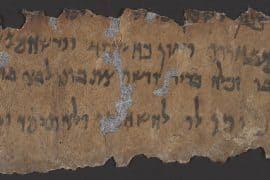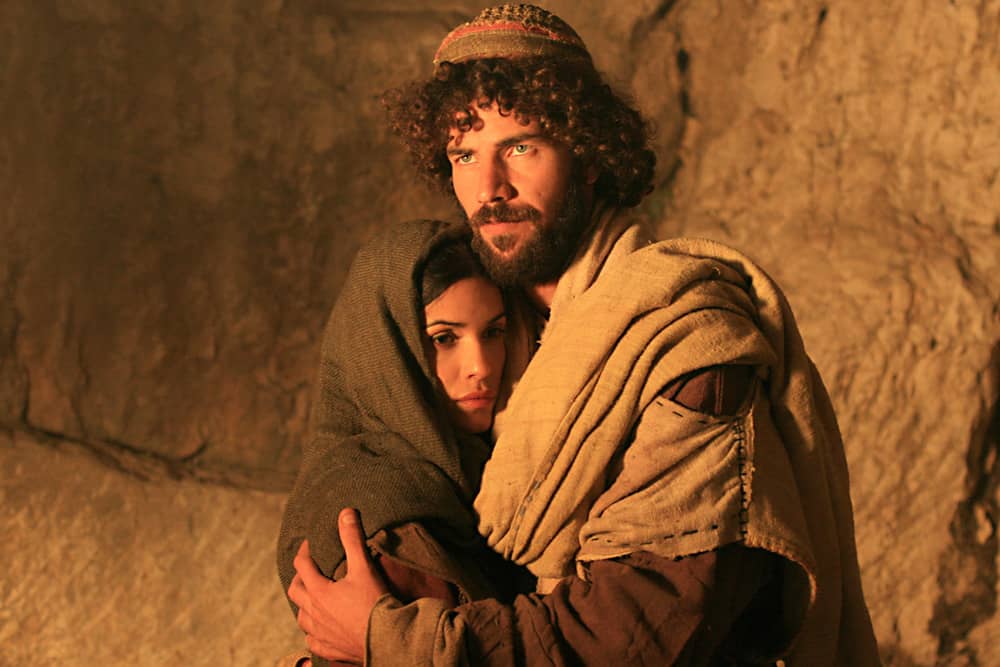The reason it is so difficult for people today to think of Jesus as a normally married Jew of his time and culture has little to do with the fact that his wife and child are not mentioned in our meager sources. It is based on an ideal of Christian asceticism that began to develop among the church fathers and mothers very early on in the 2nd century CE.
We are dealing here with a culture in which countless women are largely forgotten and unknown, their voices muted by the dominant male culture in which men are seen as the main players.
A Married Jesus and the Silence of the New Testament
Even though there is no explicit reference to Jesus being married in any of the four gospels or other New Testament writings the silence might turn out to be less deafening than one would suppose. There are several factors one must consider in making the judgment that he lived a celibate single life.[i]

First, it is important to realize that we know very little about the historical Jesus. What historians are relatively certain about could be written down on a single piece of paper. What we have in the gospels are not biographies of Jesus—far from it—but theological presentations regarding his preaching, healing, and in particular the significance of his death and resurrection. They contain almost no personal information. The gospel of Mark, for example, never names or mentions Jesus’ father while the gospel of John never names his mother. We have one childhood story, when he was twelve years old, and most scholars consider it a standard literary motif, not a historical account (Luke 2:41-52).[ii] We know nothing of his life beyond that point, including his teens and 20s when most Jewish males were expected to marry.
Second, in regards to the Twelve apostles, no wife is specifically mentioned or named for any of them. None of their children are mentioned or named—how many, what they did, or any personal details about them. Most of the Twelve, with the exception of Peter, hardly speak at all in our gospel accounts—a few lines at most.
This silence hardly means that none of them were married. In fact, there is a reference to Peter’s mother-in-law, whom Jesus healed of a fever in Mark 1:30—but her name is never given. Paul refers to the wives of the other apostles and the brothers of Jesus, but again, no names are given (1 Corinthians 9:5). He even mentions that these women accompanied their husbands on their missionary travels. We are dealing here with a culture in which countless women are largely forgotten and unknown, their voices muted by the dominant male culture in which men are seen as the main players.[iii]
Third, celibacy was not considered an ideal or valued lifestyle among Jews in the Greco-Roman period. Even though it is mistakenly believed that the Essenes, who wrote the Dead Sea Scrolls, valued and practiced celibacy, this notion is a pure invention. They were one of the three major Jewish groups of this period, along with Pharisees and Sadducees. This misunderstanding stems from the reports of Josephus the Jewish historian (37-100 CE), Philo of Alexandria, a Jewish Hellenistic philosopher (20 BCE-50 CE), and Pliny, the Elder, a Roman official (23-79 CE) about the Essenes. Each of these writers projected their own admiration of celibate idealism onto the Essenes, though, ironically, each of these writers was married. Josephus, for example, in writing of the sect of the Essenes, makes the following observation about women and marriage:
They [the Essenes] do not absolutely deny the value of marriage, and the succession of the human race is thereby continued; but they guard against the lascivious behavior of women, and are persuaded that none of them preserve their fidelity to one man.[iv]
Such a negative attitude toward women commended here by Josephus, who was unhappily married three times has no basis in history. Philo writes:
[the Essenes] repudiate marriage; and at the same time they practice self-control to a remarkable degree; for no one of the Essenes ever marries a wife, because a wife is a selfish creature, addicted to jealousy and skilled at beguiling the morals of her husband and seducing him by her continued deceptions.[v]
Pliny the Elder says that the Essenes “have no women and have renounced all sexual desire.[vi] We know that what each of these men claim about the Essenes is untrue. What is most telling here is that none of these three were celibate, all were married.
The Dead Sea Scrolls, representing over 600 texts of the period before and after the time of Jesus, were discovered hidden away in caves along the northwest shore of the Dead Sea between 1947 and 1956, never hint at celibacy, but quite the opposite. Like other pious Jews of the time, they strictly adhered to the first commandment in the Torah: “Be fruitful, and multiply, and fill the earth” (Genesis 1:28). The Scrolls are full of instructions about marriage, divorce, and avoiding fornication, or sex outside of marriage.[vii]
Jesus as well as John the Baptist have been rightly connected to the apocalyptic and messianic ideas in the Dead Sea Scrolls. Though neither was likely a formal member of the Dead Sea community, there are common ideas they share. Since the Dead Sea community is most often identified as Essenes, and it is mistakenly assumed that the Essenes practiced celibacy, the argument is often made that Jesus’ own celibacy arises out of this context
It is true that the New Testament says nothing about either Jesus or John being married, but such silence is part of the cultural norm. It is the same with the rabbis that we know from this period. There are few explicit statements about rabbis being married in the rabbinic sources, but we can be sure that marriage was the norm and not to be married an anomaly. Entire tractates of Jewish Law deal with marriage, divorce, and what is forbidden and allowed in terms of sexual behavior. As a Jew of his time we should assume that Jesus was married unless we have some statement to the contrary.
Finally, the apostle Paul is the major Jewish figure of the time who does in fact commend, but not require, celibacy, based primarily on his notion that the apocalyptic end of the age has drawn very near (1 Corinthians 7: 26, 29, 31). His was a “situational” celibacy; a practical choice one might make in view of the stressful times that he believed were imminent. Paul recommends celibacy for those who can handle a non-sexual life, but he knows most simply cannot and end up falling into fornication (1 Corinthians 7:2).
It is entirely possible, even likely, that Paul had been married earlier in his life.[viii] He says that he “advanced in Judaism beyond many of his own age,” indicating that he had formal training as a Pharisee, presumably in Jerusalem (Galatians 1:14). Since for Paul the end of the age was at hand, he thought it inopportune to invest one’s life in a gendered humanity that was soon to be transformed into a state where there would be “neither male nor female.” Paul expected to live to see a cosmic transformation—a new creation in which birth and death, and mortal states of life in general would pass away.
One of the strongest indicators that Jesus was married comes from Paul directly. He quotes Jesus freely on the prohibition against divorce, but fails to use a celibate Jesus as his major model to back his position on celibacy (1 Corinthians 7:25). In fact he says quite the opposite, that when it comes to celibacy: “I have no command of the Lord, but I give my opinion as one who by the Lord’s mercy is trustworthy” (1 Corinthians 7:25). Had Jesus been unmarried he would have undoubtedly said that all men should live like him, following the celibate ideal espoused by the Lord, but he says nothing of the kind. In this case Paul’s silence indicates that he certainly did not think Jesus was unmarried. Given these considerations one can conclude with some degree of confidence, that Jesus was most likely married, and married people at that time usually had children, as the first commandment required.
The reason it is so difficult for people today to think of Jesus as a normally married Jew of his time and culture has little to do with the fact that his wife and child are not mentioned in our meager sources. It is based on an ideal of Christian asceticism that began to develop among the church fathers and mothers very early on in the 2nd century CE.
This was not based on any historical memory of an unmarried Jesus but rather upon Paul’s commendation of celibacy—now removed from its apocalyptic conditional context.
The celibacy these Christian leaders embraced was based on an aversion to the material world and the body, seen as inferior to the unseen spiritual realities of the heavenly realms. Christians rejected this world, even hated this world, with all its imperfections. They turned their attention wholly toward the heavenly, nonmaterial world beyond. This dualistic view of the cosmos owes little to the historical Jesus the Jew and everything to Hellenistic philosophy and its ascetic ideal.[ix] Unfortunately, the negative view of women already so rife in the dominant cultural norms of the time was radically advanced by the Christian philosophers and theologians since women, and the sexual temptations they represented for men, were shunned as the ultimate obstacle to a higher spirituality. Tertullian, often called the “father of Latin Christianity,” best represents this radically misogynous trend that remains deeply ingrained in Western Christian culture to this day. Although he believed that even women could be saved by God’s grace, he warned them that the whole responsibility for the human condition lay with Eve and her successors:
You are the gateway of the devil; you are the one who unseals the curse of that tree, and you are the first one to turn your back on the divine law; you are the one who persuaded him whom the devil was not capable of corrupting; you easily destroyed the image of God, Adam. Because of what you deserve, that is, death, even the Son of God had to die.[x]
The brilliant 4th century Augustine of Hippo carried forward Paul’s perspectives and pressed their implications to the limit. He faced sexual temptations his entire life, even fathering a child with his lover, but he sought to suppress his lust by choosing a rigorously ascetic life. His famous dictim; inter faeces et uriname nascimur—“We are born between feces and urine,” yet with an immortal soul, lay at the root of his attraction and aversion to women. Perhaps the most notorious example of this unfortunate development in Christianity was the 5th century Latin theologian Jerome, the most learned of the Church Fathers. His savage condemnation of women and human sexuality was only matched by his disparagement of the “Old Testament” Law and those Jews who did not respond to Christ. He connected the two by arguing that the Old Testament was “carnal,” of the flesh, whereas Christ was spiritual and pure, from above. The virginal Christ, removed from the filth of sex, showed humankind the way to escape their fleshly bonds and achieve heavenly perfection. He even went so far as to state that a husband can best show his love of his wife by abstaining from all sexual intercourse, even in marriage. He opposed bathing, makeup, and female adornment, and saw sex, symbolized by the female temptress, as fit for pigs and dogs. Jerome wrote openly about his bouts with sexual temptations.[xi] Given this dualistic orientation towards the heavenly world and denigration of sex and birth—and therefore women as the vehicle of both, one can readily see how Mary Magdalene, Jesus, Mary the mother of Jesus, and even Joseph her husband had to be cast as living a non-sexual life. The belief that Jesus must be a perpetual virgin is firmly grounded in 2nd and 3rd century CE asceticism, not in Jesus’s own life and times.
Mary Magdalene as Sinner and Whore
It is an easy step from this stream of dualistic misogynist thinking, the core of emerging fourth and fifth century Christianity, to recasting the New Testament figure of Mary Magdalene as a sinner and even a whore. None of eleven New Testament texts that mention her present her in any negative light whatsoever. On the contrary, as we have seen, she is the leader of the band of faithful Galilean women who stand by Jesus at the cross. Even when the men have fled in fear she prepares spices and perfumed oils in order to complete the Jewish rites of burial, and she becomes a first witness to the empty tomb and Jesus’ resurrection. She enters and exits the scene in the space of a few pages of our texts—never to appear again in any New Testament text.
There are three scenes in Mark, Luke, and John respectively that recount how Jesus was anointed with a flask of costly scented oil by a woman. As they now stand in our texts they are not the same narrative, yet their core elements are so similar they appear to be three versions of the “same” story—namely of a woman anointing Jesus.
In the gospel of Mark the scene takes place in Bethany, a small village on the backside of the Mount of Olives, just east of the city of Jerusalem, two days before Jesus’ arrest and crucifixion (Mark 14:3-9).[xii] Jesus is dining as a guest in the house of one called Simon the leper, otherwise unknown. A woman arrives with a flask of pure nard ointment, broke it, and poured it over Jesus’ head. Some at the dinner protested that such a costly ointment had been wasted and could have been sold and given to the poor for 300 denarii—which would be a year’s wages for a day laborer. Jesus defends the unnamed woman’s action, saying “You always have the poor with you. She has done a beautiful thing.” He then declares:
She has done what she could. She has anointed my body for burying. And truly, I say to you, wherever the gospel is preached in the whole world, what she has done will be told in memory of her (Mark 14:8-9).
The gospel of John seems to know a very similar story (John 12:1-8; 11:1-3). Again the scene is in Bethany, but six days before the crucifixion, and at dinner in the house of the two sisters, Mary and Martha, and their brother Lazarus, whom Jesus had raised from the dead. Martha is serving but Mary took a pound of costly ointment of pure nard and anointed the feet of Jesus and wiped them with her hair. Judas Iscariot, who was to betray Jesus, objected that the ointment could have been sold for 300 denarii and given to the poor. The text points out that he did this out of greed not care for the poor, for he served as bursar of the group and used to pilfer the funds. Jesus replied:
Let her alone; let her keep it for the day of my burial. The poor you always have with you, but you do not always have me (John 12:7).
In both texts the woman has a prophetic role—anointing Jesus’ body beforehand as if he were already dead; she is commended for her actions, as if she somehow “knows” more than the others, perhaps without even realizing it herself, while the others miss the point of her actions entirely. In John the woman is named—Mary of Bethany, and her family has already been introduced (John 11). In Mark she is unidentified, with the irony that her story will be told perpetually “in memory of her.” John’s account is more shocking, since the anointing of the feet, and especially the wiping of the feet with her hair, either implies a shockingly inappropriate intimacy, or a familial bond, since men and women who are not married would never touch in this way. The hair of a woman is considered sexually provocative and was to be covered, as in conservative Middle Eastern societies today, both Jewish and Muslim.[xiii] In that sense the story is scandalous, foreshadowing the attempt of Mary Magdalene to prepare spices and anoint the corpse of Jesus when he is dead. The problem is, Mary of Bethany is not Mary Magdalene—or is she? Mark had emphasized that Mary Magdalene and her entourage came from Galilee, whereas John introduces her at the crucifixion scene as an intimate family member, standing with Jesus’ mother.
It is impossible to reconcile these differences in any forced harmony. Mark and John clearly have the same story, but their details are simply different. The strong implication in John is that Mary of Bethany is otherwise known as Mary Magdalene, and she is either married to him or otherwise considered like a sister, a part of the family. Mark knows nothing of this and never mentions Mary of Bethany.
Luke’s story recasts everything (Luke 7:36-50). The setting is in Galilee, not Jerusalem, weeks if not months before Jesus’ death. Jesus is dining at the house of a man named Simon, though it is not said he is a leper. A woman comes in off the street, unnamed, uninvited and unannounced, but known to the village as a “sinner,” which implies she was a whore. The diners are reclining, in Greco-Roman banquet style, and she stands behind Jesus at his feet and begins to weep, wetting his feet with her tears, wiping them with her hair, kissing them, and anointing them with oil. Nothing is said about the cost of the oil and the objection is not the waste but that Jesus would permit himself to be touched by such a sexually promiscuous woman and not realize, were he a prophet, her sinful status. Simon objects and Jesus rebukes him, commending the woman for her uninvited hospitality in welcoming him, washing his feet, and loving him. He declares:
Therefore I tell you, her sins, which are many, are forgiven, for she loved much; but he who is forgiven little, loves little.
He then turns to the woman and says to her, “Your sins are forgiven.” The dinner guests were even more scandalized that he could claim the right to forgive sins.
Some have doubted the parallel accounts in Mark and John are related to this one, but most scholars, knowing that Luke is using Mark as his narrative source, are convinced he is deliberately recasting the scene to disparage Mary Magdalene. He drops the anointing scene entirely from the last days of Jesus’ life, moves it to Galilee and puts it much earlier. Why would he do this?
The answer is most likely that he wants to subtly disparage Mary Magdalene. Immediately following his anointing story he introduces her by name but presents her as a terribly deranged woman, possessed with seven demons that Jesus had cast out! (Luke 8:2). Later, when he introduces the women from Galilee who stood by at Jesus’ crucifixion, he does not mention their names or put Mary Magdalene at their head. He records no appearance of Jesus to Mary Magdalene at the empty tomb, as do Matthew and John. Knowing how deeply embedded she is in early Christian tradition, Luke can not write her out of the story completely, but he can minimize and disparage her role. Later in his narrative, as a further way of distancing himself from the anointing story in the gospel of John, he presents two sisters, Mary and Martha, but has them living far outside of Jerusalem, somewhere in Galilee to the north (Luke 13:22).
The Gospel of Peter, discovered in fragments in Egypt in the 1890s, adopts and further appropriates Luke’s marginalization of Mary Magdalene. In this text Peter is prominent, narrating the events surrounding Jesus’ empty tomb, but no women are mentioned at Jesus’ crucifixion scene, standing faithfully while the men fled. Although Mary Magdalene is mentioned, and even called a mathetria—a female disciple of Jesus, who comes early Sunday morning with her friends to mourn inside the tomb, most significantly Jesus never appears to the women and they receive no commission to go and spread the good news of the resurrection to the male disciples (Gospel of Peter 12:50).
Luke’s strategy had a lasting effect. Readers of the gospels later found it easy to conflate the stories. First, it became common and accepted to identify Mary Magdalene with Mary of Bethany, the sister of Martha and brother of Lazarus. As early as the late 2nd century, Tertullian had already equated Mary Magdalene as the “woman who was a sinner.”[xiv] This salacious identification stuck. The image of Jesus as the all forgiving one—the friend of prostitutes and sinners—was both irresistible and sexually provocative. The idea of the sinful woman, like Eve, seduced by the Devil, but now redeemed, could serve as the story of all women.[xv] It was Pope Gregory the Great (540-604 CE) who sealed her fate. He conflated John’s story of Mary of Bethany with the sinful woman who anoints Jesus in Luke, and declared both women were Mary Magdalene. He waxed on as to how Mary the whore, who once perfumed herself to seduce men, flirted with her eyes, arranged her hair, and made use of her lips, now turned all those elements in chaste service to the Lord—anointing him, weeping and wiping the tears with her hair, and kissing his feet.[xvi]
In the Middle Ages Mary Magdalene became wildly popular with legends growing up regarding her missionary travels to Europe. She became the penultimate model of the hopeless sinner, transformed from a sexually fallen woman to a chaste and forgiven saint. All over Europe there are hundreds of shrines and churches dedicated to her with her supposed relics. Her feast days are among the most popular on the church calendar. It was not until the late 1970s that the Roman Catholic Church officially repudiated the connection between Luke’s sinful woman and Mary Magdalene. Ironically, on a more popular level, the myth continues and most people still think of Mary Magdalene as the deranged whore whom Jesus redeemed, spurred on by films, plays, and books such as Martin Scorsece’s The Last Temptation of Christ (based on Kazantzakis’s novel), and of course Andrew Lloyd Webber and Tim Rice’s Jesus Christ Superstar. It’s an image too hard to resist and yet if the Talpiot tomb is the tomb of the Jesus family and Mariamene can be identified with the historical Mary Magdalene, then the alternative untold story is perhaps even more compelling.
Continue here: “There’s Something About Mary…Magdalene (Part 4)”
For a complete treatment of Mary Magdalene, especially understood in the context of the two Talpiot tombs and their latest findings, see our book, The Jesus Discovery.
[i] For a typical defenses of the idea Jesus was not married by an evangelical Christian writer see, https://www.beliefnet.com/Faiths/Christianity/2003/11/Was-Jesus-Married.aspx.
[ii] Josephus mentions a similar story about his own precociousness at age fourteen, see Life 9.
[iii] See Sarah Pomeroy, Goddesses, Whores, Wives, and Slaves: Women in Classical Antiquity (New York: Schoken Books, 1995).
[iv] Josephus, War 2. 121.
[v] Philo, Hypothetica 11. 14
[vi] Pliny the Elder, Natural History 5. 73.
[vii] See the excerpt on celibacy among the Essenes by Lawrence Shiffman, Reclaiming the Dead Sea Scrolls, The Anchor Bible Reference Library (New York: Doubleday, 1995), pp. 127-144, available on-line: https://cojs.org/cojswiki/Celibacy_of_the_Essenes,_Lawrence_H._Schiffman,_Reclaiming_the_Dead_Sea_Scrolls,_Jewish_Publication_Society,_Philadelphia.
[viii] Like Jesus Paul forbids divorce, reflecting a primordial ideal, but his assertion that a Christian abandoned by an “unbelieving” mate was free from the bonds of marriage might well reflect his own experience (1 Corinthians 7: 12-16).
[ix] See Daniel Boyarin, A Radical Jew: Paul and the Politics of Identity (Berkely: University of California Press, 1997) pp. 158-179.
[x] Tertullian, On the Dress of Women 1.1.
[xi] Elizabeth Clark, Women in the Early Church (Willmington, DE: Michael Glazier, 1983.
[xii] Matthew 26:6-13 has the same story, based on his source Mark, but he specifies that the objection to the waste came from “the disciples.”
[xiii] See Paul’s insistence on covering the hair in 1 Corinthians 11:2-16.
[xiv] Tertullian, Against Marcion 4:18.9, 16-17.
[xv] See Gregory of Nyssa, the 4th century bishop, who equated Mary Magdalene with Eve, Against Eunomius 3. 10. 16.
[xvi] Homily 33 on Luke 7.









Comments are closed.